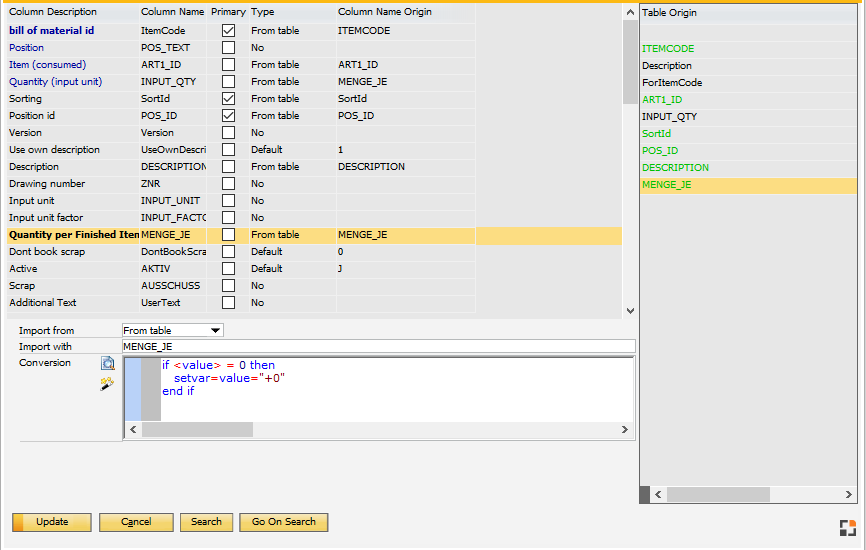|
Imports Work Order Bill of Materials definitions.
The following fields are mandatory:
| • | Document number, work order position number, bill of materials position number |
Entries can only be changed if changes are allowed and the work order position is not closed.
Position numbers:
| • | The internal position number. If this is a new number or if it is 0, Beas creates a new position. |
| • | If you do not set the position text, Beas sets the position number in position text. |
| • | The internal position number does not define the sorting. You must define this separately. See Sorting rules. |
Position text:
| • | If this is not set manually, Beas inserts the defined or generated internal position ID. |
| • | It can be defined and changed every time. |
ItemCode:
Item code is mandatory and the item must exist.
The integration hub does not check additional rules.
If you change the item and the related position, reservation or transactions exist, Beas does not change anything.
Note: If you insert an order-related item, Beas does not create an order-related sub-position.
ItemVersion:
The system check, if the Item Version is existing and not locked
But it's allowed to use it, if not released.
Quantity:
Rules for quantity in the BOM import:
| • | A value > 0 inserts a positive amount. |
| • | A value < 0 inserts a negative amount. |
| • | A value of +0 adds a position with 0 amount. |
If you only have 0 quantity in the importfile, you can convert the value

|
Delete a bill of materials position:
It is possible to delete an existing Bill of materials position. Beas requires the following fields: BELNR_ID,BELPOS_ID and POS_ID and Quantity=0.
| • | If any transaction exists on this position, the position cannot be deleted. |
| • | If a reservation exists, Beas deletes the reservation. |
| • | If the position is an order-related assembly, Beas deletes all related sub-positions. |
| • | If a deletion of a sub-position is not possible, Beas closes all related sub-positions. |
Sorting (SortId):
Defines the sorting for the bill of materials positions. You can define a positive number or special sorting rules.
Sort Id
|
Description
|
-1
|
Order by internal position number. The system searches by position, and chooses a number that is lower than the current position and higher than the lowest existing position. It receives this sortid, increments it with 1 and defines it as a sortid from the current position.
Example:
Pos 10 – Sort 10
Pos 20 – Sort 20
You insert Pos 15
Pos 10 – Sort 10
Pos 15 – Sort 11
Pos 20 – Sort 20
This is a fast variant, because Beas must only insert Pos 15, but in other situations this can generate a problem.
Example:
Pos 10 – Sort 1
Pos 20 – Sort 2
You insert Pos 15
Result in MSSQL:
Pos 10 – Sort 1
Pos 15 – Sort 2
Pos 20 – Sort 2
Result in HANA:
Pos 10 – Sort 1
Pos 20 – Sort 2
Pos 15 – Sort 2
In this case Pos 20 and Pos 15 have the same Sort id and it is not clear which position is the first position.
|
-2
|
Order by internal position number.
In this case Beas sorts the complete bill of materials position by internal position number
Beas must save every change from every bill of materials position. In case a large number of positions must be inserted, this concept produces a lot of change requests. Do not use this for mass import.
Example:
Pos 10 - Sort 10
Pos 20 - Sort 20
Pos 30 - Sort 30
You insert Pos 15
Pos 10 – Sort 10
Pos 15 – Sort 20 <- insert
Pos 20 – Sort 30 <- update
Pos 30 – Sort 40 <- update
|
-3
|
Order by position text (alphanumeric).
Example
Pos Text A10 Sort 10
Pos Text A20 Sort 20
Pos Text A50 Sort 30
You insert position with Pos Text = A30
Pos Text A10 Sort 10
Pos Text A20 Sort 20
Pos Text A30 Sort 20 <- insert
Pos Text A50 Sort 30 <- update
Attention: You can encounter the following issue when working with numbers:
Example
Pos Text 10 Sort 10
Pos Text 20 Sort 20
Pos Text 100 Sort 30
Insert Position Pos Text = 50, and the result (alphanumeric sorting) is the following:
Pos Text 10 Sort 10
Pos Text 100 Sort 20 <- update
Pos Text 20 Sort 30 <- update
Pos Text 50 Sort 40 <- insert
|
-4
|
Order by position text (converted to number)
Example
Pos Text 10 Sort 10
Pos Text 20 Sort 20
Pos Text 100 Sort 30
You insert position with Pos Text = 50
Pos Text 10 Sort 10
Pos Text 20 Sort 20
Pos Text 50 Sort 30 <- insert
Pos Text 100 Sort 40 <- update
If you insert a position with alphanumeric position text, Beas sets this to first position.
Example: insert position with text A001
Pos Text A001 Sort 10 <- insert
Pos Text 10 Sort 20 <- update
Pos Text 20 Sort 30 <- update
Pos Text 100 Sort 40 <- update
|
|
Help URL: https://help.beascloud.com/beas202102/index.html?dih_work_order_bom.htm
|
